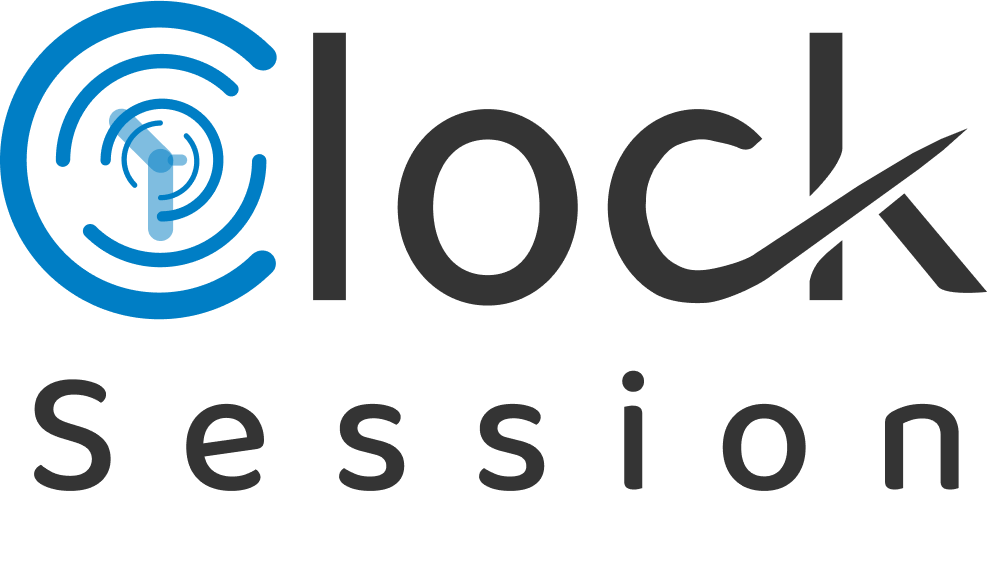Blog
Category: Time Management
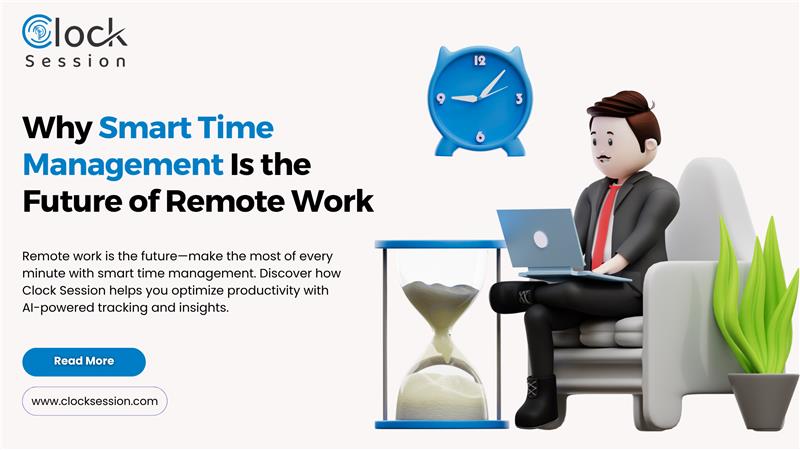
Why Smart Time Management Is the Future of Remote Work
Introduction In the evolving landscape of work, remote setups are no longer a novelty—they are becoming the norm. As teams operate across time zones, and individuals juggle personal and professional responsibilities from home, smart time management is emerging as the key to productivity, accountability, and well-being. Platforms like Clock Session are pioneering this shift, helping organizations and employees redefine how work gets done. The Rise of Remote Work The pandemic fast-tracked remote work adoption, but the benefits have made it stick. Flexibility, reduced commuting, and broader talent pools have proven too valuable to give up. However, the transition also brought unique challenges—lack of structure, time zone coordination, communication lags, and blurred boundaries between work and life. That’s where smart time management tools step in. What is Smart Time Management? Smart time management goes beyond simply setting schedules or using traditional timers. It involves the integration of data analytics, AI, and automation to manage time more effectively. With platforms like Clock Session, smart time management includes: Automated time tracking AI-driven productivity insights Customizable reports Team activity analysis Goal-setting and performance metrics These features help both employers and employees take control of their day without micromanagement. Challenges of Remote Work Without Smart Time Management Let’s face it—remote work sounds freeing, but it can spiral quickly without discipline: Procrastination increases due to lack of supervision. Team collaboration suffers when there’s no transparency in availability. Work hours expand, leading to burnout. Deadlines slip, affecting overall business outcomes. Without a strategic approach to time, teams may work harder but not smarter. How Clock Session Solves These Problems Clock Session offers a smart time management solution designed with remote teams in mind. Here’s how: 1. Automatic Time Tracking Forget manual check-ins or remembering to clock in and out. Clock Session runs in the background, capturing how time is spent on tasks and projects. This gives team leads clear data on productivity patterns. 2. Real-Time Dashboards See who’s working on what in real-time. This promotes accountability and keeps teams aligned—even across continents. 3. AI-Powered Insights Clock Session doesn’t just track time; it interprets it. The platform uses AI to suggest when productivity peaks, identifies distractions, and offers suggestions to optimize schedules. 4. Work-Life Balance Monitoring The app helps users identify when they’re overworking or underutilizing time, enabling healthier habits. It’s a major win for preventing burnout and maintaining long-term team morale. 5. Goal Alignment and Progress Tracking Remote work can make employees feel disconnected from company goals. Clock Session allows you to assign, track, and evaluate performance against objectives, ensuring everyone moves in sync. Why Smart Time Management is the Future 1. Productivity Without Pressure Rather than relying on pressure or micromanagement, smart tools encourage self-awareness. Employees become more mindful of their routines, leading to natural productivity boosts. 2. Data-Driven Leadership Leaders can now manage by data, not guesswork. They can see who’s overloaded, who’s excelling, and where support is needed—creating a culture of transparency and trust. 3. Asynchronous Collaboration Time tracking allows for better asynchronous workflows. Teams don’t need to be online at the same time to collaborate effectively. This flexibility is essential in today’s global remote teams. 4. Empowered Employees When employees know how their time is spent and can optimize it themselves, they feel more in control and empowered—reducing stress and increasing engagement. 5. Business Efficiency Smart time management translates into cost savings, better project planning, and improved client satisfaction. Every minute is accounted for, ensuring efficient use of resources. Future Trends in Time Management for Remote Work The future of time management is deeply tied to technology and human behavior. We expect to see: More AI Integration: Predictive time planning, automated scheduling, and performance forecasting. Behavioral Nudges: Apps that gently guide employees toward better habits based on behavioral data. Increased Personalization: Tools that adjust to individual working styles and rhythms. Integration with Wellness Apps: Encouraging breaks, healthy routines, and mental health tracking alongside work time. Clock Session is already moving in this direction, proving to be a forward-thinking solution for future-ready organizations. Final Thoughts Remote work is here to stay, but without smart time management, it’s easy to fall into chaos or burnout. With Clock Session, companies can equip their teams with tools that not only track time but also optimize it intelligently. This shift toward data-driven, AI-powered time management marks a pivotal point in how we approach work in the modern world. As we embrace a remote-first future, smart time management won’t just be a nice-to-have—it’ll be a critical competitive advantage.
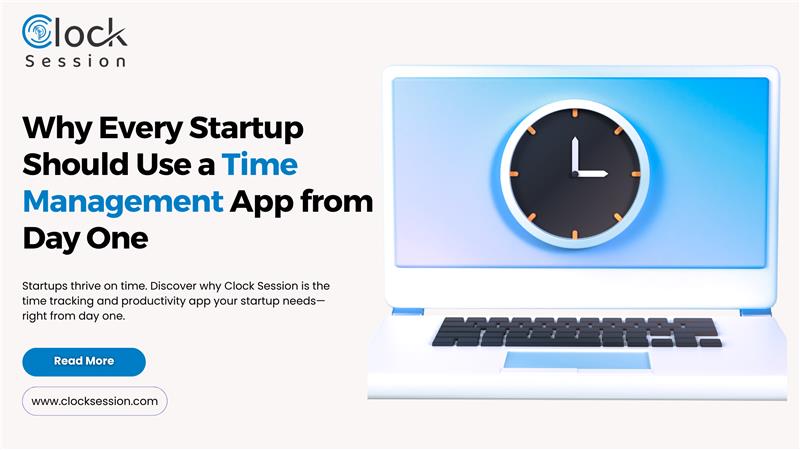
Why Every Startup Should Use a Time Management App from Day One
Introduction Launching a startup is exciting but also challenging. With limited resources, a lean team, and countless responsibilities, startups must work smarter from the beginning. One of the smartest decisions a founder can make is to implement a time management app like Clock Session from day one. Startups often fall into the trap of focusing solely on product development and customer acquisition, while neglecting internal operations. But time, if not managed well, can lead to burnout, missed deadlines, and poor performance. A time management app ensures that every minute counts, every task is accountable, and every goal is measurable. Start Strong with Structure Startups are typically fast-paced and chaotic. While creativity and innovation are crucial, structure and discipline in daily operations are equally important. A time management app gives your team a framework for task allocation, scheduling, and tracking without disrupting their flow. Clock Session allows startups to create custom schedules, allocate time for priority tasks, and monitor how time is actually spent. This visibility sets the tone for an efficient and goal-driven work culture. Build Accountability from the Ground Up In a startup, every team member wears multiple hats. Without clear time tracking, it’s hard to know where efforts are going. Clock Session fosters accountability by offering detailed insights into work patterns, helping each team member understand and improve their time usage. With performance data at your fingertips, you don’t need to micromanage. Instead, let the app provide the insights and let your team own their productivity. Stay Lean and Productive Startups operate on tight budgets. Time wasted is money wasted. By identifying inefficiencies and time-draining tasks early on, you can reallocate resources toward high-impact work. Clock Session provides real-time dashboards and automated reports to highlight where productivity drops. Use this data to remove bottlenecks and improve workflows before they affect your bottom line. Enhance Remote Collaboration Many startups operate remotely or follow hybrid models. In such setups, collaboration and communication are critical. Clock Session helps remote teams stay aligned, track their time accurately, and deliver results without constant check-ins. By tracking active hours, idle time, and completed tasks, the platform ensures transparency and promotes trust across distributed teams. Data-Driven Decisions from the Start Making decisions based on gut feeling alone is risky, especially for a startup. Clock Session turns time logs into actionable insights that guide decisions on hiring, project planning, and workload distribution. For example, if certain tasks consistently take longer than expected, you can revise timelines or provide additional support. The app helps you make smarter choices, faster. Prepare for Scaling Your startup may begin with just a few people, but if your vision is growth, then you need systems that scale. Time tracking tools grow with your team. With Clock Session, you can onboard new members, assign tasks, and generate individual performance reports—all from a single platform. By establishing time management practices early, you ensure smooth operations even as your team size increases. Boost Client Confidence and Investor Trust Startups that present organized operations and data-backed productivity metrics have an edge. Whether you’re pitching to investors or onboarding clients, being able to show time utilization and efficiency builds trust. Clock Session’s reports and insights provide that edge, showcasing your ability to manage resources wisely and deliver consistent output. Prevent Burnout and Promote Wellbeing Startup life is demanding. Long hours and blurred boundaries can quickly lead to burnout. Clock Session includes features that encourage balance, like work-hour limits, break reminders, and wellness tracking insights. By managing workload effectively and promoting healthy work habits, you create a sustainable work environment from the start. Manage Projects with Ease Project management is a major part of startup operations. Juggling multiple projects with limited resources can become overwhelming. Clock Session integrates time tracking with task management, allowing you to set timelines, assign responsibilities, and monitor progress from one dashboard. This unifies your project management approach and ensures every project stays on track. Gain Competitive Advantage Early On Time is a startup’s most valuable asset. By mastering time management early, you gain an edge over competitors who may still be relying on outdated or manual tracking systems. Clock Session ensures that your operations are efficient, your team is productive, and your goals are achieved faster. In a landscape where execution speed matters, using a time management app from day one is not just a tool—it’s a strategy. Conclusion Time is one of the few resources startups can’t afford to waste. Implementing a time management app like Clock Session from day one sets the foundation for productivity, growth, and success. Start with structure. Build accountability. Stay productive. And let your startup scale smarter with Clock Session at the core.
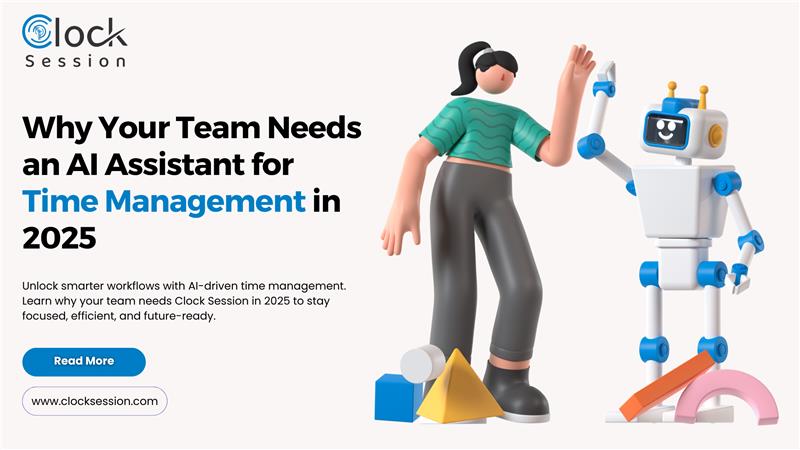
Why Your Team Needs an AI Assistant for Time Management in 2025
Introduction In today’s fast-paced and ever-evolving workplace, businesses must look beyond traditional time tracking to stay competitive. As we approach 2025, the rise of artificial intelligence (AI) is revolutionizing how teams manage time, track productivity, and streamline workflows. One of the most powerful tools leading this shift is Clock Session, an AI-powered time management assistant. So, why does your team need an AI assistant like Clock Session? Let’s explore how smart time management tools are helping businesses boost productivity, enhance employee well-being, and prepare for the future of work. Traditional Time Management is Outdated Gone are the days of manual timesheets, static calendars, and guesswork-based scheduling. These methods are prone to errors, time-consuming, and fail to give real-time insights. In a world where remote and hybrid work environments are becoming the norm, traditional methods simply can’t keep up. AI assistants like Clock Session automate time tracking and give teams accurate, real-time data on where time is spent, making every second count. This shift from manual to automated systems eliminates administrative burden and helps employees focus on meaningful work. Smarter Scheduling with AI Insights Clock Session doesn’t just log hours—it uses AI to optimize them. By analyzing past work patterns, peak productivity hours, and task complexity, the platform suggests ideal schedules. This allows team members to prioritize tasks when they’re most productive and reduces time spent on unimportant or low-value work. The result is a balanced workday that aligns with individual energy rhythms and workload demands, helping improve output without increasing burnout. Improved Accountability Without Micromanagement Managers often struggle to maintain accountability in a remote setup without feeling invasive. Clock Session bridges this gap with real-time dashboards that show active work sessions, completed tasks, and time spent on different projects—all while respecting employee privacy. Rather than micromanaging, managers get data-driven insights that build trust, encourage autonomy, and help employees self-correct their routines. Real-Time Productivity Analytics 2025 is all about real-time decision-making. Waiting until the end of the month to assess productivity just doesn’t cut it anymore. Clock Session provides live analytics and customizable reports that allow managers and employees to act immediately. Whether it’s reallocating resources or rebalancing workloads, having timely data means better results, fewer delays, and a more agile team. Personalized Work Insights AI is all about personalization. Clock Session understands that no two employees work the same way. It uses machine learning to analyze each individual’s work behavior, suggesting custom productivity strategies, break intervals, and focus periods. Over time, this feedback helps employees improve their own time management, reduces stress, and cultivates a healthier work culture. Seamless Integration with Existing Tools Clock Session integrates effortlessly with popular tools like Slack, Google Calendar, Trello, Asana, and more. This means teams don’t have to abandon their existing systems. Instead, Clock Session enhances them by bringing time intelligence into the daily workflow. By automating syncs between communication, task management, and scheduling platforms, it ensures that time tracking never becomes a bottleneck. Supports Remote and Hybrid Work Models Flexible work is here to stay, and businesses need tools that can handle distributed teams. Clock Session centralizes time data from across locations, time zones, and working hours, offering a unified view of performance. It also helps teams coordinate better with smart alerts, real-time notifications, and automated reporting—perfect for companies operating without a traditional office environment. Encourages Work-Life Balance Work-life balance isn’t just a buzzword. It’s a crucial factor in productivity and employee retention. Clock Session helps define clear work boundaries by tracking hours, prompting regular breaks, and sending gentle nudges to log off when work hours end. This AI-led approach ensures that employees maintain a healthy rhythm, reducing burnout and promoting mental well-being. Scalable and Future-Ready Whether you’re a 10-person startup or a 1,000-person enterprise, Clock Session scales with you. Its AI engine adapts to growing teams, diverse workflows, and evolving needs. With frequent updates and machine learning capabilities, Clock Session is designed to get smarter over time—delivering better recommendations and more value as your organization grows. Data-Driven Decision Making Finally, Clock Session turns data into action. With detailed performance metrics, usage trends, and time allocation reports, leaders can make informed decisions on team structure, hiring, and project planning. Instead of guessing how resources are used, you have clear evidence to guide every strategic move. Final Thoughts In 2025, time is the most valuable resource your business has. The difference between teams that thrive and teams that fall behind will come down to how well they manage their time. Clock Session is more than just a time tracker. It’s an intelligent assistant that empowers your team to work smarter, not harder. From personalized insights to real-time analytics and seamless automation, it equips your team for success in the modern workplace. If you’re ready to embrace the future of work, it’s time to bring Clock Session into your workflow.
The Psychology Behind Time Tracking: Why It Works
Introduction In a fast-paced world where distractions are just a click away, businesses are constantly searching for ways to boost productivity, accountability, and focus. One tool that’s proving to be incredibly effective is employee time tracking software—but not just for operational reasons. The real power behind time tracking lies in psychology. Understanding why time tracking works from a psychological perspective can help you make the most of tools like Clock Session and promote a more mindful, efficient, and accountable workplace. Time Awareness Improves Focus Humans have a limited attention span. Most of us underestimate how much time we spend on certain tasks or how often we get distracted. Time tracking forces individuals to become aware of how they allocate their time—and this awareness alone can drive behavioral change. Clock Session provides real-time activity insights and idle time monitoring. When employees know their time is being tracked, they are more likely to stay focused and avoid digital distractions. Psychological Principle: The Hawthorne Effect suggests that people modify their behavior when they know they’re being observed. Goal Setting and Motivation When employees log hours and see progress visually, it gives a sense of achievement. Clock Session allows for goal-based time allocation, where team members can set benchmarks for how long tasks should take and compare actual time spent. This encourages self-regulation—a psychological process where individuals monitor and adjust their behavior to meet goals. Over time, this leads to higher productivity and better work habits. Psychological Principle: The Goal-Setting Theory by Edwin Locke highlights that clear goals improve performance. Builds Accountability Without Micromanagement Contrary to popular belief, time tracking doesn’t mean employers are watching every second. With the right tool like Clock Session, it fosters a culture of self-accountability. When team members log their time, track their tasks, and review reports, they develop a habit of owning their work. This reduces the need for constant supervision and builds trust. Psychological Principle: According to Cognitive Evaluation Theory, people are more motivated when they feel in control of their actions. Reduces Procrastination and Decision Fatigue One of the biggest time drains is procrastination—often caused by lack of structure. Clock Session’s daily schedules, session logs, and smart reminders help eliminate decision fatigue by organizing your day in advance. When employees have a plan and know what to do next, they waste less time deciding and more time doing. This is especially useful in remote and hybrid work settings. Psychological Principle: Temporal Motivation Theory explains how people are more likely to take action when deadlines and rewards are clear. Increases Perceived Value of Time Time tracking makes time tangible. When employees see that a task took two hours instead of the 30 minutes they expected, it helps them reassess priorities and workflows. Over time, they develop a deeper respect for their time—and others’. Clock Session visualizes time usage in graphs, dashboards, and customizable reports, allowing both employees and managers to understand work patterns and optimize accordingly. Psychological Principle: The Endowment Effect shows that people value things more when they can measure or track ownership—this includes time. Encourages Work-Life Balance Clock Session isn’t just about working more—it’s about working smarter. By setting clear work hours, break reminders, and session limits, employees can disconnect when the day ends. This promotes better mental health, reduces burnout, and boosts long-term performance. Psychological Principle: Self-Determination Theory states that well-being and motivation improve when people feel balanced and autonomous in their work-life decisions. Makes Progress Visible One of the most satisfying things in any job is seeing progress. Clock Session lets users visualize daily, weekly, or monthly performance. This feedback loop motivates users to maintain or improve their productivity, reinforcing good work habits. Whether you’re tracking hours on a project or simply logging focus sessions, seeing how far you’ve come can be incredibly motivating. Psychological Principle: Positive Reinforcement increases the likelihood of repeated behavior when results are visible and rewarding. Conclusion: Time Tracking Is a Mindset Time tracking isn’t just a tool—it’s a mindset shift. It turns unconscious habits into conscious actions, promotes accountability, reduces procrastination, and improves work-life balance. But to truly tap into its power, you need a smart, user-friendly platform like Clock Session. Clock Session blends the science of behavior with modern productivity tools, offering everything you need to manage teams, track hours, and build a performance-driven culture. If you’re ready to transform the way your team works, Clock Session is the psychological productivity boost your business needs in 2025.

How Clock Session Helps You Achieve Work-Life Balance with Smart Time Management
Introduction In our current fast-paced digital age, the dream of a healthy work-life balance can feel more like a distant dream. How to use your time wisely has become more pressing than ever amid remote work, disparate schedules and growing work responsibilities. Clock Session is an AI-Powered work-life management application, that enables you to maximize productivity for you and your business. The Importance of Work-Life Balance Maintaining a work-life balance is essential post-burnout as it can have an adverse effect on mental health, general lifestyle and work efficiency. If your routine is imbalanced, then it may lead to stress, burnout, and less productivity. Time management enables professionals to strike a balance between work-related tasks and unleash the personal workflow by preventing work pressure. How Clock Session Enhances Work-Life Balance Clock Sessions aims to offer context-aware time management solutions to help users increase productivity and keep a balance between personal and professional life. Here’s how: 1. Automated Time Tracking One of the biggest challenges faced by professionals is managing their working hours. Clock Session provides automation time tracking to measure work hours precisely without effort. This gives you an opportunity to recognize where you are spending a lot of your time and allows you to adjust as required to increase productivity. 2. Task Prioritization and Scheduling Clock Session involves the user categorizing tasks according to urgency and importance. AI-powered insights allow professionals to prioritize and schedule their most crucial working time accordingly. A Good Smart Scheduler can help you with the best time slots you can track high-priority tasks, so it demands much more focus and less work stress. 3. AI-Powered Productivity Analytics Clock Session sends you productivity reports to highlight performance trends and the way you work. By eliminating time-wasting meetings and certain activities, users can tailor their schedule to make sure they are making the most of their time and not doing more work than what is required. 4. Break Reminders and Wellness Features However, a balanced timetable needs space, too. Clock Session also gives you reminders to take a few minutes break to avoid burnout and fatigue, reminders can also be adjusted as needed. It also comes with wellness-oriented features, including reminders to practice mindfulness and advice on how to work in an ergonomically friendly manner. 5. Seamless Integration with Work Tools Clock Session integrates with project management tools and calendars and communication platforms such as Trello, slack and google calendar. This gives complete engineer workflow management, saves a lot of time in constantly switching between the apps, thus improving productivity. 6. Remote Work Optimization For the corporate remote workers and the hybrid teams, time management becomes tricky. Clock Session has dedicated remote work monitoring features to keep employees productive without micromanaging them. Such a model promotes transparency, accountability, and autonomy while keeping a flexible work arrangement. 7. Smart Goal Setting and Performance Tracking Clock Session features an AI-driven tracking system that allows users to set their own goals and track their progress. Be it completion of a project, sticking to a tight work schedule or better utilization of time – the platform gives individualized solutions in getting work done, without overwhelming the workload. 8. Eliminating Distractions with Focus Mode Users can then filter for distractions with Clock Session’s Focus Mode by blocking out unwanted notifications and making the most important tasks stand out. This guarantees deep work focus periods, so that clients may finish work successfully and have more individual time. Benefits of Using Clock Session for Work-Life Balance Increased Productivity: Plan and schedule work hours better with AI-driven automated scheduling. Reduced Stress: Automation keeps the track on its own, thus free from working more than enough, and avoids burning out. More Personal Time: Efficient time allocation results in better separation between work and personal time. Enhanced Focus: Minimize distractions with intelligent task optimization. Greater Flexibility: Address remote and hybrid working environment challenges. Conclusion The right tools and strategies are critical to striking a healthy work-life balance. Clock Session’s AI-powered time management features help professionals balance productivity with personal wellness. Clock Session is here to help you work smarter, not harder—whether you work as a freelancer, remote worker, or business leader—to allow you more time for what really matters.
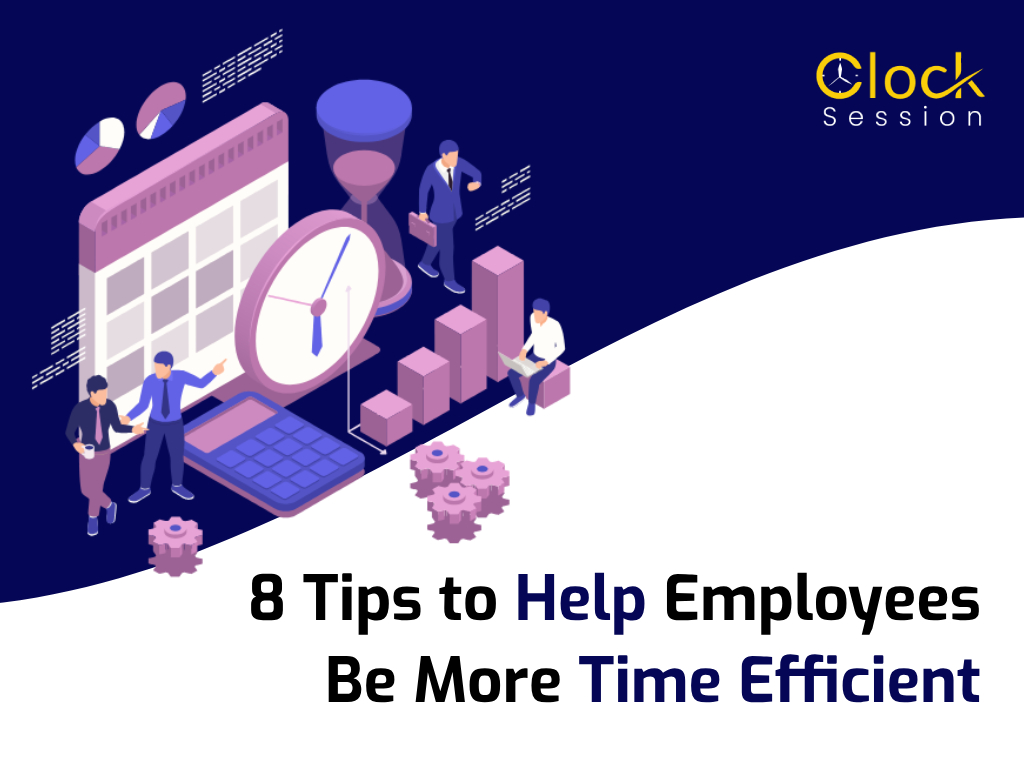
8 Tips to Help Employees Be More Time Efficient
In the fast-paced realm of the modern workplace, the ability to manage time effectively stands as a linchpin for individual and collective success. Time efficiency isn’t just a personal productivity hack; it’s a foundational principle that can elevate team dynamics and contribute significantly to overall business achievements. In this comprehensive guide, we’ll explore eight actionable tips designed to empower employees to become masters of time efficiency, transforming their workdays and propelling organizational success. 1) Prioritize Tasks with Precision: Effective task prioritization involves understanding the urgency and importance of each task. The Eisenhower Matrix is a valuable tool for this. It categorizes tasks into four quadrants: Urgent and Important: These tasks require immediate attention and should be top priorities. Not Urgent but Important: These tasks contribute to long-term goals and should be scheduled for later. Urgent but Not Important: Tasks that demand immediate attention but don’t contribute significantly to long-term goals can be delegated. Not Urgent and Not Important: Low-priority tasks that can be eliminated or postponed. Employees should regularly assess their task list and categorize items using this matrix, ensuring that their time and effort align with organizational goals. 2) Set S.M.A.R.T. Goals: S.M.A.R.T. goals provide a clear framework for goal-setting: Specific: Clearly define the goal, avoiding ambiguity. Measurable: Establish criteria for measuring progress. Achievable: Ensure the goal is realistic and attainable. Relevant: Align the goal with overall objectives. Time-bound: Set a deadline for goal completion. Encouraging employees to adhere to the S.M.A.R.T. criteria enhances goal clarity, facilitates focused efforts, and fosters a sense of accomplishment. 3) Embrace the Power of Time Blocking: Time blocking involves scheduling specific time slots for different tasks throughout the day. This method: Minimizes Distractions: Employees focus on a single task during each time block, reducing multitasking and distractions. Enhances Focus: Dedicated time for specific activities promotes deep work and concentration. Improves Productivity: Structured time management helps employees complete tasks efficiently. Organizations should encourage employees to experiment with time blocking to find a routine that suits their work style and enhances productivity. 4) Leverage Technology for Automation: Introducing technology, such as Clock Session, for time management and automation can have profound effects: Workflow Simplification: Automation streamlines repetitive tasks, freeing up time for more valuable work. Data Insights: Time-tracking tools provide data on time allocation, helping identify areas for improvement. Efficiency Gains: Automated processes reduce manual effort, minimizing errors and improving overall efficiency. Organizations should invest in technologies that align with their workflow, providing both employees and managers with tools for effective time management. 5) Conquer the Myth of Multitasking: Multitasking, often viewed as a time-saving strategy, can hinder overall productivity: Reduced Quality: Juggling multiple tasks simultaneously often leads to lower quality output. Decreased Efficiency: Constantly switching between tasks incurs a cognitive cost, slowing down overall progress. Increased Stress: Multitasking can contribute to heightened stress levels. Employees should be educated on the benefits of single-tasking, emphasizing quality over quantity and promoting a more focused and efficient work environment. 6) Emphasize the Power of Breaks: Regular breaks are essential for maintaining focus and preventing burnout: Improved Concentration: Short breaks help recharge the brain, enhancing concentration and cognitive function. Enhanced Creativity: Breaks allow for mental refreshment, fostering creative thinking. Stress Reduction: Regular breaks contribute to a healthier work-life balance, reducing stress levels. Organizations should create a culture that values and encourages taking breaks, understanding that these pauses contribute to sustained productivity.7 7) Cultivate Clear Communication: Effective communication is paramount for efficient collaboration: Avoids Misunderstandings: Clear communication reduces the risk of misunderstandings and errors. Streamlines Processes: Team members understand expectations, leading to smoother workflows. Enhances Team Dynamics: Open communication fosters a positive team environment. Encouraging transparent communication, both in person and through digital channels, is vital for creating a cohesive and efficient work culture. 8) Foster Continuous Learning: Investing in continuous learning and skill development contributes to a dynamic and adaptable workforce: Adaptability: Ongoing training ensures employees stay abreast of industry trends and technological advancements. Enhanced Problem-Solving: Continuous learning cultivates critical thinking skills, enabling employees to overcome challenges more effectively. Employee Engagement: Opportunities for skill development contribute to higher job satisfaction and employee engagement. In Conclusion: Mastering time efficiency is a journey that requires commitment, proactive measures, and a collaborative effort from both employees and organizations. By implementing these eight comprehensive tips, individuals can cultivate habits that lead to superior time management, heightened productivity, and a significant contribution to the overall success of the team and organization. As the saying goes, “Time is money,” and these strategies will help everyone make the most of it, creating a workplace where efficiency is not just a goal but a way of life. And now, introducing Clock Session – Your Partner in Time Mastery! As you embark on your journey to optimize time management, consider leveraging Clock Session, a cutting-edge solution designed to automate time tracking processes. Clock Session streamlines workflows, provides insightful data on time allocation, and empowers individuals and organizations to make data-driven decisions. Visit www.clocksession.com to explore how Clock Session can become your trusted ally in the pursuit of time efficiency. Unleash the power of automation and gain valuable insights into your time management practices. Clock Session – where every second counts toward your success! Remember, the mastery of time is not just a destination; it’s a continuous journey toward personal and professional excellence. Embrace these tips, adopt new strategies, and let Clock Session be your guide to unlocking the full potential of your time. Here’s to a future where productivity knows no bounds!

Get The Most from Your Workforce Management Platform
Workforce management is a critical aspect of any business. Effectively managing your employees’ time, tasks, and productivity can lead to increased efficiency and, ultimately, higher profits. To achieve this, many businesses turn to workforce management platforms like Clock Session. In this blog, we’ll delve into the world of workforce management and discuss how you can get the most out of your platform. Understanding Workforce Management Workforce management encompasses a wide range of activities aimed at optimizing an organization’s productivity and ensuring that its human resources are used efficiently. It involves tasks such as employee scheduling, time tracking, absence management, payroll processing, and more. These functions are crucial for any business, but they can be time-consuming and complex to manage manually. This is where workforce management platforms like Clock Session come into play. These software solutions are designed to streamline and automate various HR and workforce-related tasks, making life easier for both managers and employees. The Benefits of Workforce Management Platforms Before we dive into how to maximize the benefits of your workforce management platform, let’s explore some of the advantages these systems offer: 1) Enhanced Productivity Workforce management platforms help improve productivity by simplifying and automating various HR tasks. By automating tasks such as time tracking and scheduling, employees can focus on their core responsibilities, leading to increased efficiency. 2) Cost Reduction Effective workforce management can lead to significant cost savings. For example, accurate time tracking can help reduce labor costs by ensuring employees are paid for the hours they work and not a minute more. This reduction in unnecessary labor costs directly impacts the bottom line. 3) Compliance and Accuracy HR compliance is critical for any organization. Workforce management platforms ensure accurate record-keeping, making it easier to comply with labor laws and regulations. Accurate records and automated compliance features help businesses avoid costly penalties and legal issues. 4) Employee Satisfaction When processes are streamlined and transparent, employees tend to be more satisfied. They can easily request time off, view their schedules, and trust that they are being paid accurately. This leads to a happier and more engaged workforce, which, in turn, can positively impact productivity and customer satisfaction. Maximizing Your Workforce Management Platform Now that we’ve highlighted the benefits of workforce management platforms, let’s discuss how to make the most of your chosen platform: 1) Comprehensive Training Ensure that your team is well-trained on the platform’s features. Proper training will empower your employees to use the software effectively, making the transition smoother and more efficient. Invest in ongoing training to keep everyone updated on the platform’s capabilities. 2) Tailored Configuration Work with the platform provider to configure the software to your specific needs. Customization ensures the platform aligns with your organization’s unique processes and requirements. Consider collaborating with the platform’s support or implementation team to fine-tune the platform for your business. 3) Regular Updates Stay up to date with software updates and new features. These updates often include enhancements, bug fixes, and additional functionalities that can further improve your workforce management. Keep your software current to take advantage of the latest advancements. 4) Data Utilization Leverage the data generated by the platform. Use the insights and analytics provided to make informed decisions about staffing, scheduling, and resource allocation. Data-driven decision-making can lead to more efficient operations and improved outcomes. 5) Continuous Improvement Regularly review your processes and workflows. Identify areas where the platform can be better utilized and consider feedback from employees and managers to make improvements. Embrace a culture of continuous improvement, where you’re always looking for ways to optimize your workforce management practices. In Conclusion Your workforce management platform, like Clock Session, is a valuable asset for your business. It can significantly impact productivity, costs, compliance, and employee satisfaction. By investing in training, customization, and a commitment to continuous improvement, you can ensure that you’re getting the most from your platform. Workforce management is an ever-evolving field, and your chosen platform should evolve with it. Embrace the possibilities it offers and watch your organization thrive. Remember, the key to success in workforce management is not just having the right platform but using it to its fullest potential. For more insights on workforce management and industry trends, stay tuned to Clock Session’s blog. Clock Session – Empowering Your Workforce Management. Download Clock Session – Get started today and unleash the full potential of your workforce management.

6 Compelling Reasons to Replace Excel with a Time Tracking Tool
In today’s fast-paced and hyper-competitive business landscape, effective time management is a critical driver of success. Whether you’re a solo freelancer, a small business owner, or part of a larger corporation, the ability to accurately track and manage your time can significantly impact productivity, efficiency, and profitability. While Microsoft Excel has traditionally served as a go-to tool for time tracking, this article will delve into six compelling arguments for switching to a specialized time tracking solution. 1) Precision Through Automation One of the foremost motivations for transitioning from Excel to a dedicated time tracking tool is automation. Time tracking solutions are meticulously designed to streamline and automate the process, drastically minimizing the margin for human error. With Excel, reliance on manual data entry means constant input of start and stop times or the arduous task of manually calculating time durations. This manual approach not only risks inaccuracies but also consumes valuable time that could be better invested in more mission-critical tasks. In stark contrast, time tracking tools embrace automation to its fullest. They have the capability to automatically record time as you work, eliminating the need for constant data input. This not only augments precision but also conserves your precious time for more meaningful endeavors. 2) Real-Time Insights: The Power of Instant Information Another compelling reason to make the leap to a time tracking tool is the invaluable access to real-time insights into your work and projects. Excel falls short in delivering instantaneous updates on your time allocation. With a dedicated time tracking tool, you gain the ability to monitor your activities as they unfold, providing valuable insights into your daily schedule. These real-time insights can become your secret weapon for making informed decisions concerning resource allocation, project prioritization, and overall time management. Whether you’re a project manager striving to keep a project on the right trajectory or an individual determined to enhance personal productivity, the immediacy of data can be a game-changing asset. 3) A Catalyst for Elevated Productivity Efficiency and productivity have never been more critical in today’s business environment. Many time tracking tools come fortified with features that can substantially boost your productivity. For instance, some tools offer task reminders and notifications to help you stay on top of your to-do list. Others can categorize your time entries, offering you insights into where you might be allocating too much or too little time. Excel, on the other hand, was primarily conceived as a spreadsheet program, lacking the arsenal of productivity-enhancing features that dedicated time management tools offer. Embracing a time tracking solution can propel you towards higher levels of organization and efficiency, resulting in a noticeable uptick in productivity. 4) Streamlined Client Billing: The Professional Touch For those who bill clients based on time spent on their projects, precise and transparent time tracking is non-negotiable. Excel’s shortcomings in generating detailed, professional invoices based on your time entries are apparent. Conversely, dedicated time tracking solutions provide a seamless experience when creating invoices that vividly outline the hours worked, tasks accomplished, and applicable rates. Furthermore, many time tracking tools effortlessly integrate with accounting software, simplifying the invoicing and payment processes. This integration not only saves you time but also nurtures a professional image when interacting with your clients. 5) Astute Project Costing and Budget Management In businesses that hinge on project-based work, astute project costing stands as an indispensable cornerstone. Excel can prove cumbersome when it comes to monitoring project costs and budgets, especially when dealing with multifaceted projects. Time tracking solutions typically encompass project management features that empower you to allocate resources, monitor expenses, and track progress in real time. By harnessing these features, you can ensure that your projects adhere to budget constraints and are executed within stipulated timelines. Achieving such precision and control is a tall order when relying solely on Excel. 6) Scalability and Seamless Integration As your business expands, your time tracking requirements will naturally evolve. Time tracking solutions are crafted to be inherently scalable, adeptly accommodating the shifting demands of your burgeoning business. Whether you’re onboarding more employees, broadening your array of services, or undertaking larger-scale projects, these tools exhibit the agility to adapt to your evolving needs. Moreover, many time tracking solutions exhibit effortless integration with other software applications that hold a central role in your business operations. These integrations can smooth out your workflow, reducing the necessity for manual data entry, and consequently, heightening time savings and precision. Conclusion: A Bold Step Towards Optimized Time Management In conclusion, while Microsoft Excel has earned its stripes as a versatile tool for various applications, including time tracking, there exists a plethora of compelling reasons to contemplate a transition to a dedicated time tracking solution. Automation, real-time insights, amplified productivity, impeccable client billing, meticulous project costing, and inherent scalability with seamless integration are the undeniable benefits that await those who choose to embrace a time tracking tool. As you embark on your quest for the ideal time tracking solution, it’s essential to bear in mind that the perfect fit will hinge on your unique needs and objectives. However, the verdict is clear: making the switch from Excel to a specialized time tracking tool has the potential to revolutionize your time management approach. Why tether yourself to Excel when a time tracking tool can propel you toward unparalleled efficiency, precision, and success? The time for change is now—unleash your full potential and watch your productivity soar. Ready to make the leap to a dedicated time tracking solution? We recommend trying out Clock Session. With its robust features, seamless integration, and user-friendly interface, it is your partner in achieving optimized time management. Say goodbye to Excel’s limitations and embrace a new era of efficiency and precision. Get started with Clock Session today! {{CODEschema}}

The Importance of Setting Deadlines in Time Management
Time is a precious resource, and effective time management is essential for personal and professional success. One crucial aspect of time management is setting deadlines. In this blog post, we will explore why setting deadlines is essential and how it can significantly improve your productivity and overall efficiency. We’ll also provide practical tips on how to set and meet deadlines effectively. Understanding the Concept of Deadlines Before delving into the importance of setting deadlines, let’s first clarify what deadlines are. A deadline is a specific date or time by which a task or project must be completed. It serves as a point of accountability, creating a sense of urgency and commitment. Deadlines come in various forms: Hard Deadlines: These are fixed and non-negotiable deadlines, often set by external factors like clients, bosses, or event schedules. Missing a hard deadline can have severe consequences. Soft Deadlines: Soft deadlines are more flexible and self-imposed. While missing them may not have immediate consequences, they are essential for personal accountability and maintaining a consistent workflow. Now, let’s explore why setting deadlines in time management is crucial. Deadlines Create Focus and Prioritization One of the primary benefits of setting deadlines is that they force you to prioritize your tasks. When you have a clear deadline, you are more likely to concentrate your efforts on the most important and urgent tasks first. This helps prevent procrastination and ensures that you are working on tasks that align with your goals. Without deadlines, it’s easy to become overwhelmed by a long to-do list and lose sight of what truly matters. Deadlines act as a guiding light, helping you channel your energy and attention towards meaningful and productive work. Deadlines Enhance Productivity Deadlines provide a sense of urgency, which can be a powerful motivator. When you know you have limited time to complete a task, you are more likely to stay focused and make efficient use of your time. This heightened focus can lead to increased productivity and better work quality. Moreover, deadlines can help you avoid the common trap of perfectionism. When you have a deadline to meet, you’re more inclined to aim for “good enough” rather than obsessing over every detail. This can prevent unnecessary delays and ensure that you deliver results on time. Deadlines Improve Time Estimation Setting deadlines requires you to estimate how much time a task will take realistically. Over time, this practice can help you become better at gauging how long different types of tasks will take. Improved time estimation is a valuable skill in time management because it allows you to allocate your time more effectively and avoid overcommitting. As you gain experience in setting and meeting deadlines, you’ll develop a more accurate sense of your capabilities and limitations. This self-awareness can guide your future planning and help you avoid unrealistic expectations. Deadlines Foster Accountability Deadlines are not only about managing your time but also about being accountable for your commitments. When you set a deadline, you make a promise to yourself or others that you will deliver by that time. This sense of accountability can be a powerful motivator to stay on track and fulfill your obligations. Meeting deadlines consistently builds trust and reliability, both valuable traits in personal and professional relationships. It demonstrates that you are dependable and can be counted on to deliver results as promised. Deadlines Reduce Stress While deadlines can create pressure, they can also help reduce overall stress. Without deadlines, tasks can linger indefinitely, causing ongoing worry and uncertainty. Setting deadlines provides structure and a clear endpoint, which can alleviate the anxiety associated with open-ended projects. Additionally, deadlines can prevent last-minute rushes and the need to work long hours to meet unexpected, looming deadlines. When you plan your work and set realistic deadlines, you can distribute your workload more evenly, leading to a healthier work-life balance. Deadlines Facilitate Progress Tracking Setting deadlines allows you to track your progress effectively. By breaking down larger projects into smaller tasks with deadlines, you can monitor how well you advance toward your goals. If you notice that you’re falling behind schedule, you can adjust your approach or allocate more resources to catch up. Progress tracking also enables you to celebrate achievements along the way. Each deadline met is a milestone reached, providing a sense of accomplishment and motivation to continue working towards your larger objectives. Tips for Setting and Meeting Deadlines Effectively Now that we’ve established the importance of setting deadlines in time management, let’s explore some practical tips for doing so effectively: Set Realistic Deadlines: Avoid setting deadlines that are too ambitious or too lenient. A realistic deadline should consider the complexity of the task, your available resources, and potential obstacles. Prioritize Tasks: Assign deadlines based on the priority and importance of each task. Urgent and critical tasks should have earlier deadlines. Break Projects into Milestones: For complex projects, break them into smaller, manageable milestones with their deadlines. This makes the project more approachable and allows for better progress tracking. Use Time Management Tools: Leverage time management tools and apps to help you schedule and track your deadlines. Popular tools include calendars, task management apps, and project management software. Avoid Procrastination: Procrastination is the enemy of meeting deadlines. Use techniques like the Pomodoro Technique or time blocking to stay focused and minimize distractions. Review and Adjust: Regularly review your deadlines and adjust them as needed. Life is dynamic, and unexpected events can occur, so flexibility is key. Seek Accountability: Share your deadlines with someone who can hold you accountable, whether it’s a colleague, friend, or mentor. Celebrate Achievements: Acknowledge your accomplishments when you meet deadlines. Reward yourself to stay motivated and maintain a positive attitude. In conclusion, setting deadlines in time management is not just a practical tool; it’s a fundamental principle for achieving success. Deadlines help you stay focused, enhance productivity, improve time estimation, foster accountability, reduce stress, and facilitate progress tracking. By following the tips provided, you can become a master of setting and meeting deadlines,
